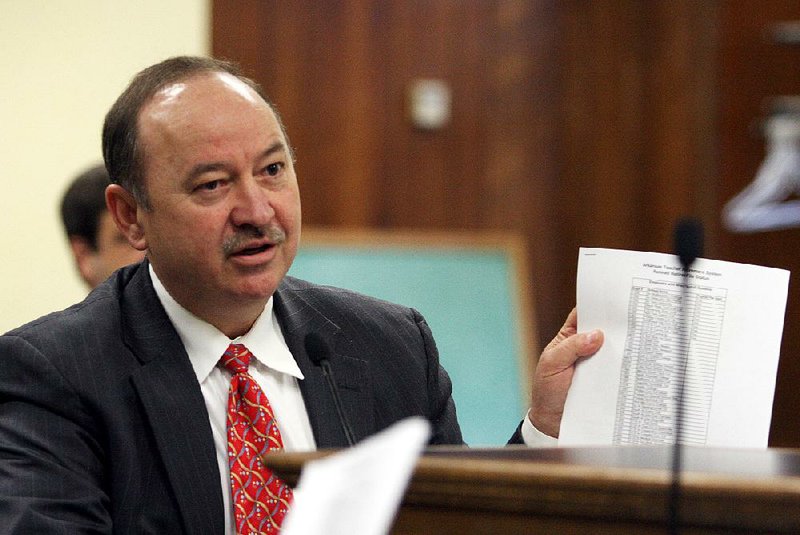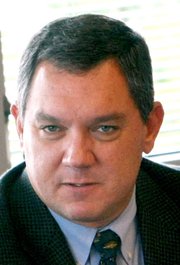The trustees of state government's largest retirement system want lawmakers to give them more flexibility to raise money and cut costs when facing economic downturns and other changes.
"I think we need to show that we have the fiduciary responsibility to take care of the system," Richard Abernathy told his fellow trustees of the Arkansas Teacher Retirement System last month. If the system's investments take a downturn, "we need to, as a board, to step up and make sure that this system remains solvent.
"Personally, I want us to take care of it versus legislators having to step in to take care of it for us," said Abernathy, who also is executive director of the Arkansas Association of Educational Administrators.
In 2013, the Legislature enacted several laws allowing the system's trustees to increase the rates charged to employees, school districts and other employers, and cut costs, but only if the system's projected payoff period for its unfunded liabilities exceeded 30 years.
The proposed changes for the coming legislative session would grant the trustees the authority to take these actions "if actuarial soundness becomes an issue, based upon current and future assumptions, mortality tables, and accounting rules," the system's staff said in a written report to the trustees. The Legislature begins meeting in regular session starting Jan. 9.
System Executive Director George Hopkins said that under existing law, the trustees are restricted from taking proactive action to shore up the system's finances until they receive an actuary report projecting a period of longer than 30 years to pay off its unfunded liabilities.
Unfunded liabilities are the amount by which the system's future obligations -- such as the amount that will be needed to pay retirement benefits -- exceed an actuarial value of the system's assets. Actuaries often compare unfunded liabilities to mortgages.
"If we see markets [heading] the wrong way or we need to make adjustment, we need some flexibility to make the changes before that next fiscal year kicks in," and to provide sufficient notice to system members, he said.
Under state law, the payroll rate charged to school districts and other employees is now 14 percent but can be gradually increased to 15 percent if the payoff period for unfunded liabilities exceeds 30 years. Employees pay a 6 percent rate of payroll and that can be increased by trustees to 7 percent under the same payoff period restriction.
The system's projected payoff period of its unfunded liabilities dropped from 33 years as of June 30, 2015, to 29 years as of June 30 last year, according to actuary Gabriel, Roder, Smith & Co. of Southfield, Mich. The total of the unfunded liabilities dropped from $3.7 billion on June 30, 2015, to $3.57 billion on June 30, 2016.
The system's investments were valued at $14.9 billion as of Sept. 30, according to investment consultant Aon Hewitt Investment Consulting of Chicago. The system's investment return for the one-year period ending Sept. 30 was 10 percent, ranking it among the top 25 percent of the nation's public pension systems, according to Aon Hewitt.
Officials for Gabriel said it's likely that their study of the system next year will reflect a need for the system to lower its projected investment return from the current 8 percent a year. If the projected return drops, that will put "upward pressure" on the 29-year projected payoff period, they said.
Actuaries for Gabriel could recommend reducing the projected return to 7.5 percent or 7.75 percent a year as soon as the system's June 30, 2017, actuarial valuation, Hopkins said. An actuarial valuation shows the financial condition of the system.
If the projected return is cut and the system doesn't have large investment returns, the system will have to find ways to raise or save money, Hopkins said.
[EMAIL ALERTS: Sign up for free breaking news updates + daily newsletters with top headlines]
In the scenario in which the rate is cut to 7.5 percent a year and there is no large investment return, the system would need to raise or save $75 million, Hopkins said. By cutting the rate to 7.75 percent, the system would need to come up with $37.5 million a year more in funds or savings, he said.
"We need to have the mechanisms in place for this board to make the surgical changes necessary to maintain our stability versus depending upon somebody else to make those changes," Hopkins told the board in December. "Hopefully, our investment returns will soar, and we have to do nothing. Investment returns cure all ills and eliminate all problems."
Act 1446 of 2013 allows the trustees to increase the 14 percent rate charged to system employers by 0.25 percentage point a fiscal year to a maximum 15 percent, but only if an actuarial report shows that the system's projected payoff period for unfunded liabilities exceeds 30 years. Under the proposed law, trustees would not have to wait for the projected payoff period to reach that level to take this step.
A 0.25 percentage-point rate increase would raise about $7.5 million more a year for the system, so a 1 percentage-point increase would raise $30 million more a year for the system, Hopkins said.
Act 1446 of 2013 also states that any rate increase may be enacted only "if the system implements cost savings from member benefit programs or increased member contributions or both, measured after July 1, 2013, that equal or exceed the value of the employer contribution increase before or at the same time as an employer contribution."
The proposed law change "would still require an appropriation by the General Assembly" for a rate increase, according to the system's staff report. Act 1399 of 2013 requires an employer rate increase to be paid from funds appropriated to the state Department of Education.
Act 602 of 2013 allows the trustees to increase the 6 percent rate of payroll charged to the system's working members, if the projected unfunded liability payoff period exceeds 30 years. Again, the trustees want the payoff period restriction removed.
A 1 percentage-point increase in that rate would raise $22 million a year more for the system, Hopkins said.
Trustees also want the unfunded liability payoff period restriction removed from other laws, to allow them to take these steps if needed:
• Act 603 of 2013 allows the trustees to cut the $75 monthly stipend paid to retired members.
While the trustees indicated that they would phase in any changes in the stipend benefit, once the phase-in is complete, each $25 reduction in the stipend would save about $15 million a year, Hopkins said.
The trustees also want to provide that "if the stipend were to be changed, that the impact of the change be spread in such a way so that retirees will not see an actual reduction of benefits at any time," according to a system staff report.
• Act 967 of 2013 allows the trustees to reverse the 2009 compounding of the annual 3 percent cost-of-living adjustment for system retirees and other participants. This step would lessen increases in retirement benefits.
The trustees also want to provide that if the change takes effect, retirees would not see a reduction of benefits, according to a system staff report.
Not compounding the cost-of-living adjustment would save the system about $22 million a year currently, Hopkins said. However, the annual savings from this step would drop every year because of deaths of members who received a higher benefit from the compounding, he said.
• Act 966 of 2013 allows the trustees to change the multiplier for service earned after July 1, 2013, for members paying into the system to between 1.75 percent and 2.15 percent, and the multiplier for members not paying into the system to between 0.5 percent and 1.39 percent. It also requires that service earned by members through June 30, 2013, would be subject to the current multiplier of 2.15 for members who pay into the system and 1.39 percent for members who don't.
Among other proposed changes is one regarding outsourced employees. The trustees want to require school districts to either pay a surcharge of up to 10 percent of the payroll of their outsourced employees or have the outsourced employees become system members, said system Deputy Director Gail Bolden.
"The decision would be made by the individual school district after the law becomes effective. Certain employers, such as colleges and employers that offer an alternative plan, are not subject to the provisions within the bill. The bill does have a phase-in provision," she said.
Abernathy, one of the trustees, said some school district officials want their outsourced employees to be in the Teacher Retirement System, while other school district officials favor paying a surcharge of their outsourced employees' salaries to the system. Some school district officials don't want to have to do anything to help the retirement system deal with its dropping number of working members resulting from districts contracting out certain services, Abernathy said.
"At the end of the day, when you say, 'Do you want to do something like this,' or 'Do you want to start cutting benefits,' they don't really want to cut benefits," Abernathy said, referring to school district officials. "It is an issue we are going to have to wade through. Will it have unanimous support? No. They are not going to be excited about it."
As of June 30, the Teacher Retirement System had 68,368 working members with an average age of 44.4 years, average service of 10.3 years and average salary of $37,235 a year, Gabriel reported.
The system also includes 43,095 retired members with retirement benefits totaling $984 million -- an average of $22,833 a year -- and 3,864 deferred retirement plan participants with a total payroll of $239 million -- an average salary of $61,853 a year -- according to Gabriel.
School districts and other system employers paid $408.6 million into the system in fiscal 2016, while their employees contributed $128.6 million, Hopkins said.
SundayMonday on 01/01/2017

